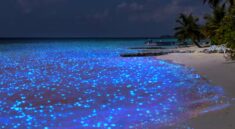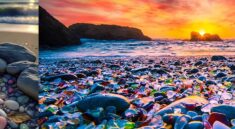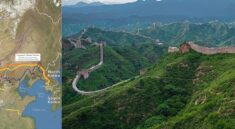The Dead Sea: A Natural Wonder of Unparalleled Beauty
Nestled in the heart of the Jordan Rift Valley, the Dead Sea stands as a captivating testament to nature’s extraordinary allure. Renowned for its unique characteristics and historical significance, this remarkable saltwater lake has long been a magnet for those seeking rejuvenation and awe-inspiring landscapes.
The Dead Sea, bordered by Jordan to the east and Israel and the West Bank to the west, is a saltwater lake unlike any other. Its shores mark the Earth’s lowest elevation point on land, creating an otherworldly landscape that captivates visitors from around the globe.
The high salt concentration of the Dead Sea, nearly ten times saltier than regular seawater, allows bathers to effortlessly float on its surface. Rich in minerals such as magnesium, calcium, and potassium, the mud and waters of the Dead Sea have earned a reputation for their therapeutic properties, drawing health-conscious travelers seeking natural remedies.
Visitors to the Dead Sea can engage in a range of activities, from floating effortlessly in the hypersaline waters to applying mineral-rich mud for a natural spa experience. Exploring nearby attractions, such as Qumran Caves and Ein Gedi Nature Reserve, adds cultural and natural dimensions to the journey.
How to get there
Getting to the Dead Sea involves traveling to the surrounding countries, primarily Jordan and Israel, as the Dead Sea is bordered by these nations. Here are the general guidelines for reaching the Dead Sea:
**1. Travel to Jordan:
- Air Travel: If you are traveling to the Jordanian side of the Dead Sea, you can fly into Queen Alia International Airport (AMM) in Amman, the capital of Jordan. From there, you can arrange transportation to the Dead Sea region, which is approximately an hour’s drive from Amman.
- Road Travel: If you are already in Jordan, you can take a taxi or rent a car to reach the Dead Sea area. Major roads lead to the Dead Sea from Amman, making it easily accessible by car.
**2. Travel to Israel:
- Air Travel: If you are planning to visit the Dead Sea from the Israeli side, you can fly into Ben Gurion International Airport (TLV) in Tel Aviv or Ramon Airport (ETM) in Eilat. From there, you can arrange transportation to the Dead Sea region.
- Road Travel: If you are already in Israel, you can drive or take a bus to the Dead Sea. The Dead Sea is accessible by road from cities like Jerusalem and Tel Aviv.
**3. Travel Between Jordan and Israel:
- Border Crossings: There are border crossings between Jordan and Israel, and you can cross overland. The Sheikh Hussein Bridge (Jordan River Crossing) and the Allenby Bridge are two common border crossings between the two countries. Keep in mind that border crossing requirements and regulations may vary, so it’s essential to check the latest information and have the necessary visas and permits.
**4. Resorts and Hotels:
- Many resorts and hotels are situated along the shores of the Dead Sea in both Jordan and Israel. Some visitors opt to stay in these accommodations, where they can access private beaches and facilities.
Tips:
- Visa Requirements: Check the visa requirements for the country you plan to visit (Jordan or Israel) and ensure you have the necessary documentation before traveling.
- Transportation Options: Consider renting a car or hiring a driver for more flexibility in exploring the region. Public transportation and organized tours are also available.
- Checkpoints: Be aware of any security checkpoints or restrictions, especially if you plan to travel between Jordan and Israel.
- Travel Insurance: Consider having travel insurance that covers medical emergencies and unexpected situations.
- Weather: Be prepared for the region’s warm and arid climate, especially during the summer months. Stay hydrated and use sunscreen.
Things to do
The Dead Sea offers a unique and diverse range of activities, combining natural wonders with therapeutic experiences. Here are some things to do when visiting the Dead Sea:
**1. Float on the Surface:
- Experience the unparalleled buoyancy of the Dead Sea by floating effortlessly on its surface. The high salt concentration makes it almost impossible to sink, providing a surreal and relaxing floating sensation.
**2. Apply Dead Sea Mud:
- Cover yourself in the mineral-rich mud found along the shores of the Dead Sea. The mud is believed to have therapeutic properties and is often used for skincare. Allow it to dry before rinsing it off in the salty waters.
**3. Wellness and Spa Treatments:
- Explore the world-class spa facilities and resorts along the Dead Sea’s shores. Indulge in therapeutic treatments, massages, and wellness programs that harness the healing properties of the Dead Sea’s minerals.
**4. Visit Ein Gedi Nature Reserve:
- Explore the nearby Ein Gedi Nature Reserve, a lush oasis with waterfalls, hiking trails, and diverse flora and fauna. The reserve offers a refreshing contrast to the arid landscapes of the surrounding area.
**5. Tour Qumran Caves:
- Discover the historical significance of the Qumran Caves, where the Dead Sea Scrolls were found. Take a guided tour to learn about the ancient manuscripts and the archaeological site.
**6. Sunset Watching:
- Witness breathtaking sunsets over the Dead Sea. The changing colors of the sky, reflected on the salty waters, create a mesmerizing spectacle. Find a peaceful spot along the shoreline to enjoy this natural beauty.
**7. Photography:
- Capture the stunning landscapes, salt formations, and unique textures of the Dead Sea. The contrast between the salt-encrusted shores and the deep blue waters against the backdrop of desert mountains provides ample opportunities for striking photographs.
**8. Dine by the Dead Sea:
- Enjoy a meal at one of the Dead Sea’s restaurants or resorts, savoring local and international cuisine. Some establishments offer outdoor seating with panoramic views of the sea.
**9. Hike Masada:
- Embark on a hike to the ancient fortress of Masada, located on a plateau overlooking the Dead Sea. The historical site offers panoramic views and insights into the region’s rich history.
**10. Stargazing: – Experience the tranquility of the desert night and indulge in stargazing. The low light pollution in the area provides an excellent opportunity to observe the night sky.
**11. Bird Watching: – The Dead Sea region is home to diverse bird species. Birdwatchers can explore the area’s natural reserves and wetlands for the chance to spot unique avian life.
**12. Shopping for Dead Sea Products: – Visit local markets or specialized shops to purchase Dead Sea skincare products, salts, and mud. These products are renowned for their cosmetic and therapeutic benefits.
**13. Explore the Baptism Site (Jordan): – Visit the Baptism Site on the Jordanian side of the Dead Sea, believed to be the location where Jesus was baptized by John the Baptist. The site has historical and religious significance.
Things not to forget
When visiting the Dead Sea, it’s important to be well-prepared to ensure a comfortable and enjoyable experience. Here are some things not to forget:
**1. Swimwear:
- Bring appropriate swimwear to fully enjoy the unique experience of floating on the surface of the Dead Sea. Ensure your swimwear is comfortable and suitable for the saltwater.
**2. Water Shoes:
- Wear water shoes to protect your feet from the salt-encrusted shores. The crystallized salt can be sharp, and water shoes provide added comfort when walking along the shoreline.
**3. Sunscreen:
- The Dead Sea region has intense sunlight, so apply a high SPF sunscreen to protect your skin from sunburn. Don’t forget to reapply throughout the day, especially if you spend extended periods outdoors.
**4. Hat and Sunglasses:
- Bring a wide-brimmed hat and sunglasses to shield yourself from the strong sun. The glare off the saltwater can be intense, so eye protection is essential.
**5. Water and Hydration:
- Stay hydrated, especially in the arid climate of the Dead Sea region. Carry a reusable water bottle and drink plenty of fluids to prevent dehydration, particularly if you are spending time outdoors.
**6. Towel:
- Pack a towel to dry off after floating in the Dead Sea or applying mud. Many visitors also bring a dedicated beach towel for comfort.
**7. Dead Sea Mud Products:
- If you plan to apply Dead Sea mud, consider bringing your own mud mask or purchasing locally. The mud is known for its therapeutic properties and is a popular activity at the Dead Sea.
**8. Floatation Devices:
- While floating on the Dead Sea is a natural occurrence, some visitors prefer using floatation devices for added support. If desired, bring a small inflatable float or noodle for extra buoyancy.
**9. Camera or Smartphone:
- Capture the stunning landscapes and memorable moments with a camera or smartphone. The unique setting of the Dead Sea offers excellent photo opportunities.
**10. Waterproof Bag: – Protect your belongings, such as electronic devices and valuables, by using a waterproof bag. This is particularly useful if you plan to take them with you into the water.
**11. Comfortable Footwear: – Besides water shoes, bring comfortable footwear for walking around the resorts, attractions, or nearby nature reserves.
**12. Snorkeling Gear (Optional): – If you enjoy snorkeling, consider bringing your own gear. While the Dead Sea doesn’t have coral reefs like traditional snorkeling destinations, some visitors enjoy exploring the underwater scenery.
**13. Cash and Credit Cards: – Have some local currency (Jordanian dinars or Israeli shekels) for small purchases or tips. Credit cards are widely accepted, but it’s good to have cash on hand.
**14. Travel Adapter: – If traveling from a country with different electrical outlets, bring a travel adapter to charge your electronic devices.
**15. First Aid Kit: – Carry a basic first aid kit with essentials such as bandages, pain relievers, and any necessary medications.
Best time to visit
The best time to visit the Dead Sea depends on your preferences and the type of experience you seek. The region has a desert climate with hot temperatures and low humidity, making it accessible year-round. Here are considerations for different seasons:
**1. Spring (March to May):
- Pros: Mild temperatures, ranging from 20°C to 30°C (68°F to 86°F). Spring brings blooming flowers and pleasant weather, making it an ideal time for outdoor activities and exploration.
- Cons: While temperatures are moderate, it’s advisable to stay hydrated, especially during daytime excursions.
**2. Summer (June to August):
- Pros: Hot and dry weather with temperatures often exceeding 35°C (95°F). Summer is ideal for those seeking intense heat and relaxation by the water. The high salt concentration in the Dead Sea prevents the water from becoming uncomfortably warm.
- Cons: The summer months are the peak of the tourist season, leading to crowded beaches and accommodations. The intense heat may be challenging for some visitors.
**3. Autumn (September to November):
- Pros: Similar to spring, autumn offers mild temperatures and is considered a shoulder season with fewer tourists. The weather is comfortable for outdoor activities, and the landscape retains its beauty.
- Cons: As autumn progresses, temperatures may cool down, so it’s advisable to bring layers, especially in the evenings.
**4. Winter (December to February):
- Pros: Mild temperatures during the day, ranging from 10°C to 20°C (50°F to 68°F). Winter is an excellent time for those who prefer cooler weather and want to avoid the heat of the summer.
- Cons: While winter is considered the off-peak season, it can still be busy, especially during holidays. Nights can be cooler, so it’s advisable to bring layers.
Factors to Consider:
- Crowds: The Dead Sea attracts visitors year-round, but summer sees the highest number of tourists. If you prefer a quieter experience, consider visiting during the shoulder seasons (spring or autumn).
- Weather Preferences: If you enjoy hot weather and want to experience floating in the warm waters of the Dead Sea, summer may be the preferred season. If you prefer milder temperatures, spring and autumn are ideal.
- Outdoor Activities: Spring and autumn provide comfortable temperatures for outdoor activities such as hiking, exploring nearby nature reserves, and enjoying the scenery.
- Special Events: Check for any local events or festivals that may coincide with your visit, adding a cultural dimension to your experience.
- Wellness and Spa: If you are primarily interested in wellness and spa treatments, any season is suitable, but consider the weather and your comfort level.
Why is the Dead Sea so famous?
The Dead Sea is famous for several unique features and characteristics that contribute to its global renown:
- High Salt Concentration:
- The Dead Sea has an exceptionally high salt concentration, nearly ten times saltier than regular seawater. This high salinity prevents most aquatic life from thriving in its waters and allows individuals to float effortlessly on the surface.
- Mineral-Rich Mud:
- The shores of the Dead Sea are covered in mineral-rich mud, known for its therapeutic properties. Visitors often apply this mud to their skin, believing it has benefits for various skin conditions and overall skincare.
- Lowest Elevation on Earth:
- The shores of the Dead Sea mark the lowest point on Earth’s land surface, situated approximately 430 meters (1,411 feet) below sea level. This geographical feature adds to the uniqueness and allure of the region.
- Historical and Biblical Significance:
- The Dead Sea has historical and biblical significance, with references dating back to ancient times. It is mentioned in historical texts and is believed to be the site of cities mentioned in the Bible. The area around the Dead Sea, including Masada, Qumran, and the Baptism Site, holds archaeological and religious importance.
- Therapeutic and Wellness Tourism:
- The minerals present in the Dead Sea, including magnesium, calcium, and potassium, are believed to have therapeutic properties. The region has developed into a hub for wellness tourism, attracting visitors seeking natural remedies for skin ailments and other health conditions.
- Floating Experience:
- The high salt concentration allows individuals to float effortlessly on the surface of the Dead Sea. This unique experience attracts tourists from around the world, making it a popular destination for those seeking an unusual and buoyant swimming encounter.
- Scenic Landscapes:
- The surrounding landscapes of the Dead Sea, including the stark desert mountains and arid terrain, contribute to its dramatic and captivating scenery. The contrast between the deep blue waters and the salt-encrusted shores creates a visually striking environment.
- Resorts and Spas:
- Over the years, the Dead Sea region has developed into a destination for luxury resorts and spa facilities. These establishments offer a range of wellness treatments, mud applications, and relaxation experiences against the backdrop of the unique natural surroundings.
- Environmental Challenges:
- The Dead Sea faces environmental challenges, including decreasing water levels. Efforts to address these issues, such as conservation projects and awareness campaigns, have also contributed to the global recognition of the Dead Sea.
The combination of these factors has made the Dead Sea an iconic and world-renowned destination, attracting travelers for its natural wonders, historical significance, and therapeutic offerings. Whether for floating in its buoyant waters, applying mineral-rich mud, or exploring the surrounding historical sites, the Dead Sea continues to captivate visitors from diverse backgrounds.
Can you swim in the Dead Sea?
While you can certainly enter the water of the Dead Sea, traditional swimming as you would experience in other bodies of water is not as common due to its extremely high salt concentration. The high salinity, about ten times saltier than regular seawater, provides a unique buoyancy that makes floating exceptionally easy. The salt content is so high that it becomes challenging to sink, and individuals naturally bob on the surface.
Here are some key points to keep in mind regarding swimming in the Dead Sea:
- Floating Experience: The primary attraction of the Dead Sea is the ability to effortlessly float on the surface of the water. This natural buoyancy is a result of the high salt concentration, which makes it a distinctive and enjoyable experience.
- Cautionary Measures:
- Avoid submerging your face or eyes in the water, as the high salt content can cause irritation. It’s recommended to keep your head above water.
- Be cautious about any cuts or open wounds, as the saltwater can cause discomfort.
- Buoyancy Aids:
- While many visitors enjoy the natural buoyancy of the Dead Sea without any aids, some may choose to bring small inflatables or floatation devices for added support and relaxation.
- Not Suitable for Traditional Swimming:
- The high salinity makes traditional swimming strokes challenging, and attempts to swim in a conventional manner may result in a less enjoyable experience.
- Wash Off Thoroughly:
- After floating, it’s advisable to rinse off in fresh water to remove the salt and mud from your skin.
- Enjoy the Therapeutic Mud:
- Take advantage of the mineral-rich mud along the shores of the Dead Sea. Many visitors apply this mud to their skin, letting it dry before entering the water and then rinsing off for a therapeutic experience.
While you won’t experience traditional swimming in the Dead Sea, the unique floating sensation and the therapeutic qualities of the water and mud make it a must-try experience for visitors. It’s essential to follow guidelines and be mindful of the high salt concentration to ensure a safe and enjoyable visit to the Dead Sea.
What are 5 facts about the Dead Sea?
- Exceptionally High Salinity:
- The Dead Sea has an extraordinarily high salt concentration, around 30% salinity, making it nearly ten times saltier than regular seawater. This high salinity prevents most marine life from thriving in its waters, and it contributes to the unique buoyancy that allows individuals to effortlessly float on the surface.
- Lowest Point on Earth:
- The shores of the Dead Sea mark the Earth’s lowest elevation point on land, approximately 430 meters (1,411 feet) below sea level. This geographical feature adds to the uniqueness and allure of the region.
- Rich in Minerals:
- The Dead Sea is rich in minerals, including magnesium, calcium, potassium, and bromine. These minerals are believed to have therapeutic properties and are often used in skincare and wellness treatments. Visitors commonly apply the mineral-rich mud found along the shores for its purported health benefits.
- Historical and Biblical Significance:
- The Dead Sea has historical and biblical significance, with references dating back to ancient times. It is mentioned in historical texts and is believed to be the site of cities mentioned in the Bible. The nearby fortress of Masada, the Qumran Caves (where the Dead Sea Scrolls were discovered), and the Baptism Site add to the historical and cultural richness of the region.
- Environmental Challenges:
- The Dead Sea faces environmental challenges, including decreasing water levels. The diversion of water sources and evaporation due to the arid climate contribute to the shrinking of the sea. Efforts are underway to address these environmental issues and find sustainable solutions to preserve the unique ecosystem.
What is the Dead Sea used for?
The Dead Sea is used for various purposes, ranging from tourism and wellness to industrial and agricultural applications. Here are some key uses of the Dead Sea:
- Tourism:
- The Dead Sea is a major tourist destination, attracting visitors from around the world. Tourists come to experience the unique buoyancy of the water, apply mineral-rich mud for its purported therapeutic benefits, and explore the surrounding historical and cultural sites.
- Wellness and Spa Tourism:
- The mineral-rich mud and water of the Dead Sea are believed to have therapeutic properties. The region has developed into a hub for wellness tourism, with numerous resorts and spa facilities offering a range of treatments, massages, and relaxation experiences.
- Mineral Extraction:
- The Dead Sea is a source of various minerals, including magnesium, potassium, calcium, and bromine. These minerals are extracted for commercial and industrial purposes. Potash, a potassium-rich salt, is a significant product extracted from the Dead Sea and is used as a fertilizer.
- Cosmetic and Skincare Products:
- The minerals and mud from the Dead Sea are key ingredients in many cosmetic and skincare products. Products such as soaps, creams, and masks utilize the natural properties of Dead Sea minerals for their perceived benefits to the skin.
- Salt Production:
- The high salinity of the Dead Sea makes it a source of salt production. The salt extracted from the Dead Sea is used for various industrial purposes, including chemical manufacturing and de-icing roads.
- Research and Conservation:
- The unique environment of the Dead Sea, including its high salt concentration and extreme conditions, attracts scientific research. Researchers study the Dead Sea to understand its geological, ecological, and environmental characteristics. Conservation efforts are also underway to address the challenges posed by decreasing water levels.
- Agricultural Use:
- The minerals extracted from the Dead Sea, such as potash, are used as fertilizers in agriculture. These minerals contribute essential nutrients to crops, enhancing soil fertility.
- Religious and Cultural Significance:
- The Dead Sea holds religious significance in various cultures and is mentioned in historical texts, including the Bible. Pilgrims and tourists visit sites like Masada and the Baptism Site for their historical and cultural importance.
Image credit: static.toiimg.com





